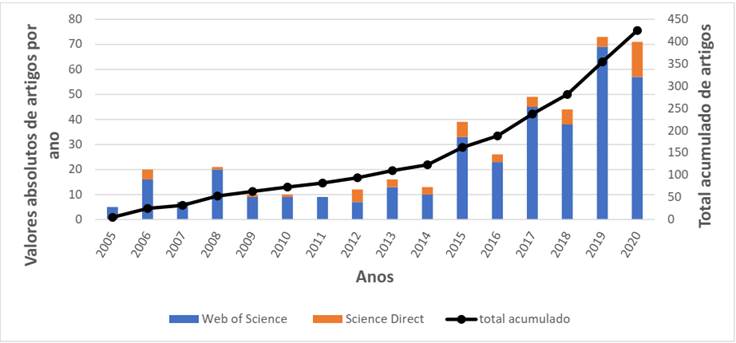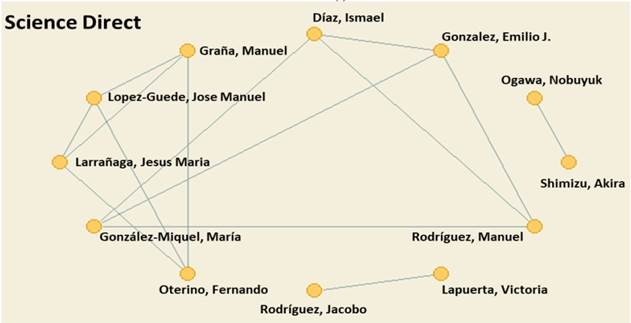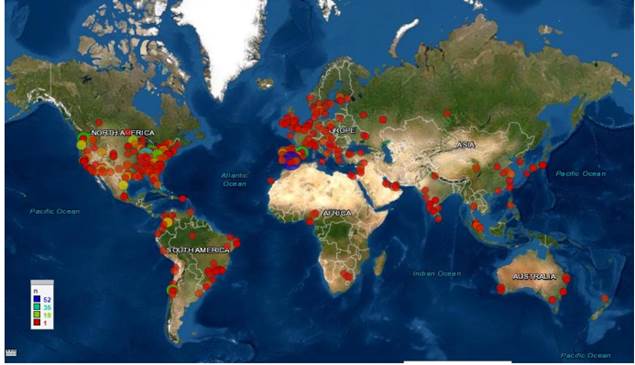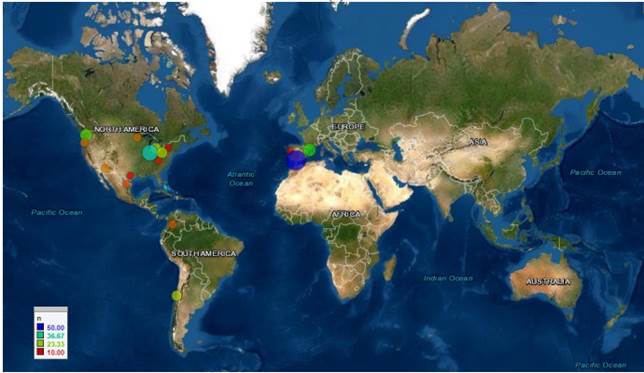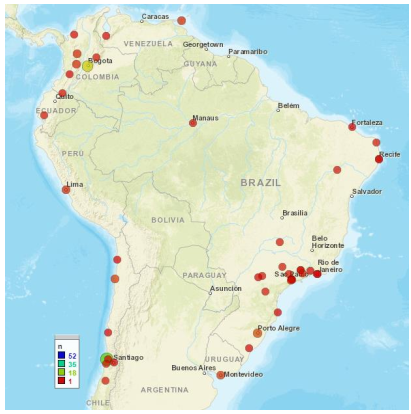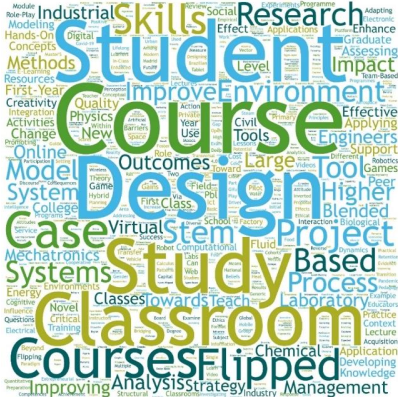INTRODUÇÃO
As metodologias ativas podem ser entendidas como métodos de ensino que envolvam ativamente os estudantes durante o processo de aprendizagem. Por meio de ações e atividades significativas, os alunos tem reflexões sobre o que estão fazendo e o que estão aprendendo. Alternativamente, tais abordagens podem ser indicadas na literatura como ensino indutivo. Tais métodos tem em comum o fato de que o aluno assume uma maior responsabilidade e protagonismo pelo seu aprendizado, que pode estar baseado em pesquisas e/ou atividades colaborativas, envolvendo discussão e solução de problemas. O professor assume uma posição de facilitador da aprendizagem, não atuando como fonte primária do conhecimento, avaliando e observando o progresso de seus estudantes e dando o auxílio necessário, em momentos específicos. Como resultado do engajamento dos discentes, nota-se uma maior retenção e compreensão dos conteúdos abordados, além de uma maior atenção e concentração nas atividades propostas (Hernández‑de‑Menéndez et al.; 2019; Prince, 2004; Prince e Felder, 2006).
Apesar de serem consideradas recentes e modernas, as metodologias ativas já eram destacadas por autores clássicos na Educação no início do século XX, tais como John Dewey e Lev Vygotsky, no contexto da formação escolar de crianças e jovens. O primeiro salientava a importância de que o conhecimento passado em sala de aula deveria ser sempre introduzido por situações reais, que gerassem interesse dos alunos em aprender, já que a educação deveria ser considerada como um processo de vida e não como um processo de preparação para uma vida futura (Williams, 2017). Já o segundo indicava as atividades interativas, tais como discussões produtivas, feedbacks construtivos e a colaboração com os outros, como fundamentais para a construção do conhecimento, sendo o professor o principal promotor e motivador deste tipo de interação (Kurt, 2020). Ambas as características enfatizadas por estes autores são pilares fundamentais das metodologias ativas aplicadas em tempos atuais.
Mesmo com as diferentes vantagens e os bons resultados do uso de metodologias ativas, a maioria dos professores ainda prefere as metodologias tradicionais, especialmente os professores das áreas de Ciência, Tecnologia, Engenharia e Matemática (comumente agrupadas pela sigla em inglês STEM - Science, Technology, Engineering and Mathematics) (Stains et al. 2018). Os principais motivos alegados pelos professores são tempo insuficiente para preparo das aulas com novas metodologias, recursos limitados, falta de apoio institucional, dificuldade de abordar conteúdos e fazer avaliações usando tais abordagens, resistência dos estudantes em participarem das atividades ativas propostas, em assumirem a responsabilidade pelo seu aprendizado e de serem forçados a realizarem atividades em grupo (Deslauriers et al., 2019; Felder, 2010; Henderson et al., 2007).
Apesar de tais fatos, universidades e docentes, em iniciativas próprias, tem considerado os diferentes benefícios das metodologias ativas e tem investido em ambientes e situações propícias para sua adoção nos currículos do ensino superior (Hernández‑de‑Menéndez et al.; 2019). A necessidade de formar profissionais com capacidade técnica aliada à capacidade de resolução de problemas, presentes no dia-a-dia das profissões, incentiva o uso dessas abordagens com os estudantes universitários, nas mais diferentes áreas. O desenvolvimento de competências e habilidades valorizadas pelo mercado de trabalho, tais como o pensamento crítico, a análise e resolução de problemas, a liderança, o trabalho em equipe, o uso de tecnologias da informação e da comunicação, dentre outros; também são consequências atraentes ao uso das metodologias ativas (Prince e Felder, 2006).
A pandemia do Covid-19, as ações de distanciamento social e a súbita implantação do ensino remoto também acelerou a utilização de abordagens ativas. Neste contexto, os docentes se viram desafiados a manter um ensino atrativo e qualidade, por meio das telas de computadores, celulares e TVs. O uso de métodos de maior engajamento dos estudantes, em conjunto com ferramentas tecnológicas, apresenta elevado potencial para a manutenção do desempenho e do aprendizado, mesmo em tempos em que os encontros presenciais não foram possíveis (Donitsa-Schimdt e Ramot, 2020; Palmeira et al., 2020; Singhal et al., 2020).
Considerando este contexto, o objetivo geral deste trabalho é verificar a evolução temporal, no Brasil e no mundo, do uso de metodologias ativas no contexto de cursos superiores de Engenharia, por meio de um mapeamento sistemático da literatura. Especificamente, busca-se identificar os principais pesquisadores envolvidos nas pesquisas desta área nos últimos anos, sua localização geográfica, além de verificar a presença brasileira nestas pesquisas. A partir de uma análise breve dos títulos, resumos e palavras-chave dos trabalhos listados, busca-se identificar qual a metodologia ativa mais utilizada pelos docentes dos cursos superiores de Engenharia. Busca-se assim compreender como tais metodologias tem adentrado as salas de aula destes cursos e como os docentes e discentes tem recebido esta mudança no processo de ensino-aprendizagem.
MATERIAIS E MÉTODOS
O trabalho consiste em um mapeamento sistemático, que de acordo com Kitchenham e Charters (2007), corresponde a um estudo secundário que visa a identificação e classificação de um tema/conteúdo relacionado a um tópico de pesquisa. Seus resultados permitem uma ampla investigação do tema escolhido, possibilitando a averiguação das principais características, conclusões e lacunas da literatura, assim como a sugestão de novos estudos e a utilização de novos métodos, enfoques e/ou abordagens. A realização do mapeamento sistemático demanda a construção de um protocolo de pesquisa, composto de sete etapas básicas (Petersen et al., 2008; Petersen et al., 2015), ilustradas na Figura 1.
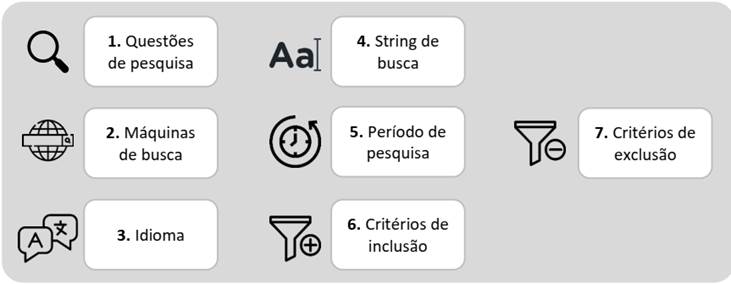
Figura 1 Sete etapas básicas do protocolo de pesquisa de um mapeamento sistemático (Fonte: Adapatado de Petersen et al., 2015)
Para este trabalho, tais etapas foram assim definidas:
1. Questões de pesquisa: inicialmente, foram definidas 4 questões de pesquisa a serem respondidas neste mapeamento sistemático:
É possível observar um crescimento do uso de metodologias ativas nos cursos de Engenharia, a partir das publicações encontradas pelo protocolo de pesquisa estabelecido e para o período de estudo selecionado?
Quais os periódicos são os maiores veículos de divulgação dos trabalhos envolvendo metodologias ativas nos cursos superiores de Engenharia? E quais são os autores e como estes se conectam na produção de tais trabalhos?
Qual a distribuição geográfica dos pesquisadores que publicaram trabalhos neste período? É possível estabelecer um recorte da presença brasileira nestas pesquisas?
Ao avaliar os títulos, resumos e palavras-chaves dos trabalhos selecionados, é possível identificar as metodologias ativas mais utilizadas / relatadas pelos pesquisadores?
2. Máquinas de busca: Web of Science (WoS) e ScienceDirect (SciDir). Tais plataformas foram escolhidas por englobarem periódicos que divulgam resultados das áreas de Engenharia.
3. Idioma: Inglês. A escolha deste idioma leva em conta o seu uso majoritário em publicações científicas e a obrigatoriedade de seu uso nas máquinas de busca elencadas.
4. String de busca (ou descritores): (“active learning”) AND (“education”) AND (“engineering”). Os termos de busca englobam palavras em inglês comumente utilizadas nas publicações que abordam as metodologias ativas e a educação no contexto dos cursos superiores de Engenharia.
5. Período de pesquisa: 2005 a 2020. Acredita-se que o intervalo de quinze anos seja interessante para averiguar as questões de pesquisa estabelecidas. Ao mesmo tempo, será possível estabelecer um cenário prévio a ocorrência da pandemia de Covid-19, que pode ter estimulado o uso de metodologias ativas.
6. Critério de inclusão: serão considerados trabalhos que possuam as strings de busca no título, no resumo e nas palavras-chave.
7. Critério de exclusão: serão considerados apenas trabalhos de pesquisa originais (filtro “Article type - Research articles” no Science Direct e filtro “Document type - Articles” no Web of Science).
Com a aplicação deste protocolo, foi realizada a extração dos dados, que resulta em uma lista de estudos primários. Os dados presentes nesta lista foram sintetizados em gráficos e tabelas, elaborados a partir do uso das seguintes ferramentas computacionais:
BibExcel (Persson et al., 2009): ferramenta para análises de dados bibliográficos, extraídos das máquinas de busca na forma textual, e que podem ser convertidas em planilhas eletrônicas, para análise quantitativa e geração de gráficos.
Pajek (Nooy et al., 2018): ferramenta para geração de redes de colaboração entre autores de artigos, a partir de arquivos gerados na análise com a ferramenta BibExcel.
GPS Visualizer: ferramenta online para a produção de mapas, a partir de dados de localização dos autores dos estudos listados neste mapeamento sistemático
WordCloud: ferramenta online para produção de nuvem de palvaras presentes nos títulos, resumos e palavras-chaves dos estudos listados.
Esta síntese de dados buscou encontrar as respostas às questões de pesquisa estabelecidas para este mapeamento sistemático. Tais respostas incluem a verificação do avanço da presença da temática de metodologias ativas em cursos superiores de Engenharia ao longo dos últimos anos; a identificação dos principais veículos de divulgação de tais pesquisas e quais os principais pesquisadores envolvidos e a identificação das metodologias ativas preferidas pelos professores da área de Engenharia.
RESULTADOS E DISCUSSÃO
A aplicação do protocolo de pesquisa estabelecido resultou na localização de 433 trabalhos de pesquisa originais, sendo 55 resultados obtidos a partir do Science Direct (SciDir) e 378 resultados obtidos no Web of Science (WoS). Foi verificada a existência de 17 repetições de trabalhos, que foram encontrados em ambas as máquinas de busca, os quais foram retirados e considerados uma única vez. Assim, o número final considerado foi de 416 publicações, as quais estão indicadas no Apêndice A (título e ano de publicação).
A distribuição temporal das publicações é apresentada na Figura 2, considerando o período de pesquisa estabelecido, entre 2005 e 2020. Esta figura diferencia os trabalhos encontrados em cada máquina de busca, além de indicar o total acumulado de publicações a cada ano. Os anos com maior número total de trabalhos publicados foram 2019, com 73 publicações (17,5% do total), sendo 69 oriundas do WoS e 4 oriundas do SciDir; e 2020, com 71 publicações (17,1% do total), sendo 57 vindas do WoS e 14 vindas do SciDir.
É possível observar um aumento expressivo na quantidade de obras publicadas a partir do ano de 2015. Até esse ano, o total de trabalhos divulgados foi de 153, o que equivale a 36,8% das publicações encontradas neste mapeamento. Já entre 2015 e 2020, foram publicados 263 artigos científicos sobre metodologias ativas em cursos superiores de engenharia, correspondente a 63,2% das obras mapeadas e a 1,72 vezes o número de trabalhos identificados entre 2005 e 2015.
Tais resultados são indicativos do crescimento da presença das metodologias ativas nas salas de aula dos cursos superiores de Engenharia, com uma aceleração de seus usos e dos relatos presentes na literatura científica internacional após o ano de 2015 e com picos nos últimos dois anos do período de pesquisa considerado (2019 e 2020). A repetição deste protocolo de pesquisa, em um período posterior, pode ser interessante, a fim de averiguar como o prolongamento da pandemia do Covid-19 pode ter afetado este crescimento, considerando o contexto de isolamento social e de ensino remoto.
Os trabalhos presentes neste mapeamento sistemático foram publicados em 124 periódicos científicos diferentes. A Figura 3 destaca as cinco revistas com maior número de publicações deste mapeamento e a respectiva quantidade de trabalhos veiculados nestes jornais.
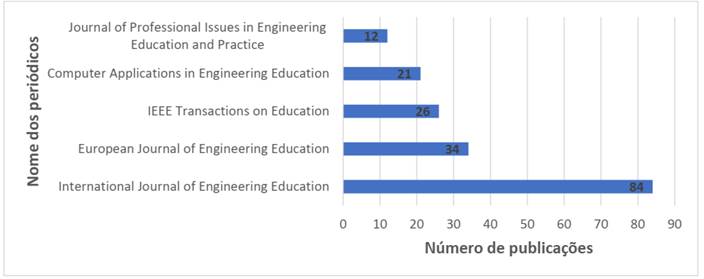
Figura 3 Periódicos com maior número de publicações científicas sobre metodologias ativas em cursos superiores de Engenharia, considerando o protocolo de pesquisa estabelecido. (Fonte: Autores, 2022)
O periódico que apresentou o maior número de trabalhos foi o International Journal of Engineering Education (IJEE / ISSN: 0949-149X) com 84 trabalhos, o que corresponde 20,1% das publicações mapeadas. Em seguida, com 34 trabalhos (8,2% do total), observa-se o European Journal of Engineering Education (EJEE / ISSN: 0304-3797). Ambos os periódicos publicam atualmente seis edições por ano e tem em seus escopos a veiculação de pesquisas científicas com foco no desenvolvimento da educação voltada para a Engenharia, em âmbito global e continental.
Os periódicos IEEE Transactions on Education (IEEE ToE / ISSN: 0018-9359) e Computer Applications in Engineering Education (CAE / ISSN: 1061-3773) foram, respectivamente, a terceiro e a quarta revistas com mais publicações neste mapeamento. A IEEE ToE está vinculada ao Instituto de Engenheiros Eletricistas e Eletrônicos (IEEE) e procura veicular pesquisas educacionais ligadas a cursos superiores de Engenharia Elétrica, Eletrônica e de Computação. Tal resultado destaca a presença desta área da Engenharia entre as que mais divulgam seus resultados de metodologias ativas na literatura científica. Já a revista CAE aborda estudos sobre o uso de computadores, Internet, ferramentas e softwares, no contexto da educação de Engenharia, o que também destaca as iniciativas de professores em englobar novas tecnologias, aliadas a metodologias ativas, no contexto de formação dos alunos.
A Figura 4 apresenta os cinco autores mais presentes nos estudos analisados. Este levantamento considerou tanto a posição de autor principal, como de co-autor dos trabalhos. Nos 416 trabalhos analisados, 671 pesquisadores estiveram envolvidos, o que corresponde a uma média de 1,61 pesquisador envolvido por trabalho. Maura Borrego (University of Texas at Austin, EUA) foi a pesquisadora com maior número de trabalhos, com 6 participações, sendo 4 delas como primeira autora. Shane Brown (Oregon State University, EUA) foi o segundo, com 5 participações, sendo 2 como autor principal. Jeffrey Rhoads (University of Purdue, EUA), Noboyuki Ogawa (Gifu National College of Technology, Japão) e José Manuel Lopez-Guede (Universidad del Pais Vasco, Espanha) completam a lista. Um fato interessante e comum a tais pesquisadores é sua formação incial em Engenharia e a realização de estudos posteriores, buscando integrar as metodologias ativas aos cursos que pertencem.

Figura 4 Autores com maior número de participação em trabalhos, considerando o protocolo de pesquisa estabelecido (Fonte: Autores, 2022)
As Figuras 5a e 5b apresentam as redes de conexão entre os autores envolvidos nos estudos listados neste mapeamento, divididos pela máquina de busca (Science Direct e Web of Science, respectivamente). Uma conexão indica que um autor publicou ao menos um trabalho com o outro. Não é possível apresentar todos os 671 pesquisadores envolvidos nestas figuras nem todas as conexões existentes. Desta forma, as conexões mais frequentes são exibidas nas figuras.
É interessante notar que a interação entre tais autores não é intensa, o que indica a realização de estudos mais locais, que relatem experiências em cada universidade ou em cada curso em que estão envolvidos. Mesmo os autores com mais publicações, apresentados na Figura 3, apresentam poucas colaborações. Maura Borrego e Noboyuk Ogawa apresentam uma única colaboração frequente, enquanto José Manuel Lopez-Guede apresenta três conexões frequente, sendo todas de mesma nacionalidade. Shane Brown e Jeffrey Rhoads não aparecem nestas redes, uma vez que seus trabalhos foram sempre realizados com diferentes profissionais, pouco frequentes na divulgação dos resultados por meio dos artigos.

Figura 5 Redes de conexão entre autores participantes dos trabalhos, divididos em função da máquina de busca: (a) Science-Direct e (b) Web of Science. (Fonte: Autores, 2022)
Quando observamos a lista dos autores com mais trabalhos e as redes de conexão mais frequentes, é possível avaliar que há um predomínio de autores americanos e europeus, especialmente espanhóis. Tal avaliação pode ser confirmada na Figura 6, que exibe a localização geográfica dos pesquisadores envolvidos nos trabalhos listados neste mapeamento. Esta avaliação foi realizada apenas para os trabalhos obtidos pela máquina de busca Web of Science, já que os resultados da pesquisa nesta plataforma, em formato textual, forneciam tal informação, enquanto o Science Direct não fornecia.
Figura 6. Mapa de localização dos pesquisadores envolvidos nas pesquisas listadas neste mapeamento sistemático, a partir da Web of Science. Tamanho do círculo e cores indicam as quantidades em cada cidade/região. (a) localização de todos os autores envolvidos; (b) localidades que apresentaram 10 ou mais trabalhos; (c) localidades de origem dos primeiros autores. (Fonte: Autores, 2022)
Ao se observar todos os autores (Figura 6a), é possível avaliar o predomínio da nuvem de pontos sobre os Estados Unidos e a Europa. Círculos coloridos e de maior diâmetro indicam as localidades com maior presença dos pesquisadores. Madrid (Espanha), com 59 repetições; West Lafayette (Estados Unidos), com 39 repetições; e Barcelona (Espanha), com 29 repetições são as cidades com mais autores participantes nas pesquisas listadas.
O predomínio americano e europeu sobre os demais continentes fica ainda mais evidente na Figura 6b, que restringe as localidades que apresentaram ao menos 10 repetições. Nesta condição, nota-se a inexistência de pontos na Ásia, Oceania e África, além de uma grande redução na presença de trabalhos oriundos da América do Sul. Nesta última região, destacam-se os trabalhos realizados no Chile e na Colômbia, que em termos de uma mesma localidade, apresentaram mais trabalhos que o Brasil.
Já a Figura 6c exibe a localização dos primeiros autores. O predomínio europeu e americano continua evidente, considerando que tais regiões possuem uma rede de pesquisa sobre o tema e investimentos em ciência já consolidados, fazendo com que se tornem as principais referências internacionais (Reis et al., 2017). A presença de pesquisadores liderando publicações em todos os continentes é um fato animador, no sentido de que as metodologias ativas já estão difundidas mundialmente e de que há uma preocupação dos professores de Engenharia em trazê-las para a sala de aula.
A Figura 7 apresenta um recorte dos mapas para o continente sul-americano, de forma a destacar o Brasil. Ao se comparar o mapa de todos os autores (Figura 7a) e o mapa de primeiros autores (Figura 7b), nota-se bastante semelhança, o que indica que os pesquisadores brasileiros, em diferentes regiões, lideraram pesquisas relativas à metodologias ativas voltadas aos cursos de Engenharia. Numericamente falando, 40 pesquisadores participaram de tais trabalhos, sendo que 17 destes possui um pesquisador brasileiro como primeiro autor. Quatro das cinco regiões brasileiras apresentaram ao menos uma participação em trabalhos sobre metodologias ativas. Apenas a região Centro-Oeste não teve representantes. A maior concentração de trabalhos foi vista nas regiões Sul e Sudeste, havendo trabalhos oriundos tanto das capitais, quanto de cidades do interior. Apesar deste recorte otimista, acredita-se que o Brasil pode ainda evoluir na realização de pesquisas e na implementação de metodologias ativas nos cursos de Engenharia. É importante salientar que o protocolo desta pesquisa levantou apenas trabalhos publicados internacionalmente e que muitos pesquisadores podem optar por divulgar suas pesquisas em âmbito nacional, por meio periódicos e eventos no próprio país, cujos trabalhos não foram captados neste levantamento.
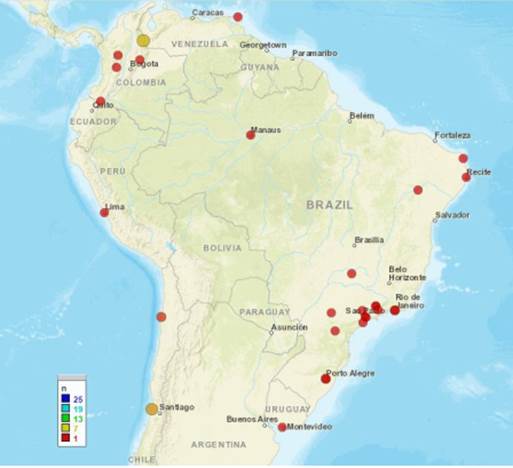
Figura 7 Localização dos pesquisadores brasileiros e sul-americanos envolvidos nas pesquisas listadas neste mapeamento sistemático, a partir da Web of Science. Tamanho do círculo e cores indicam as quantidades em cada cidade/região. (a) localização de todos os autores envolvidos; (b) localidades de origem dos primeiros autores. (Fonte: Autores, 2022)
Por fim, a Figura 8 apresenta três nuvens de palavras obtidas, a partir dos textos dos títulos (Figura 8a), resumos (Figura 8b) e palavras-chave (Figura 8c) dos trabalhos. A montagem destas nuvens de palavras desconsiderou os termos “active learninng”; “education” e “engineering”, que foram utilizados como critério de pesquisa dos estudos presentes e inevitavelmente estariam presentes em elevada quantidade nestas nuvens de palavras. Buscou-se aqui verificar os termos com mais repetições e que poderiam ser indicativos das metodologias ativas relatadas pelos autores em cada estudo. Palavras com fontes em maior tamanho são indicativas de maiores repetições.
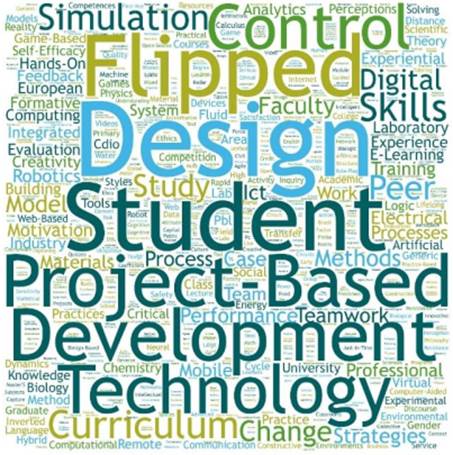
Figura 8 Nuvens de palavras obtidas a partir de (a) títulos; (b) resumos e (c) palavras-chave de todos os trabalhos listados neste mapeamento. Palavras com maiores fontes apresentaram um maior número de repetições. (Fonte: Autores, 2022)
Na análise destes resultados, buscou-se agrupar as palavras em categorias, de forma a elencar motivos indicativos da sua repetição nos textos avaliados. As categorias foram:
Palavras com muitas repetições e que descrevem elementos da universidade, que inevitavelmente são utilizadas na descrição do ambiente em que as publicações foram realizadas. Destacam-se os termos “student” (estudante); “course(s)” (cursos); “classroom” (sala de aula); “practices” (práticas); “strategies” (estratégias); “curriculum” (currículo); “higher education” (ensino superior);
Palavras com muitas repetições e que descrevem elementos de trabalhos científicos:palavras comuns da linguagem de artigos científicos, tais como “study” (estudo/trabalho); “research” (pesquisa); “outcomes” (resultados); “results” (resultados, resulta em); “impact” (impactos); “change” (mudanças); “analysis” (análise); “improving” (melhorias).
Palavras ligadas à engenharia e à tecnologia: termos como “desgin” (projeto); “development” (desenvolvimento); “technology” (tecnologia); “digital” (digital); “simulation” (simulação); “systems” (sistemas); “tools” (ferramentas); que são palavras comumente presentes no vocabulário dos engenheiros e que podem estar encaixadas nas disciplinas em que as metodologias ativas foram aplicadas.
Palavras relativas à habilidades e competências desenvolvidas pelos estudantes: podem ter sido utilizadas no sentido de descrever quais os principais resultados esperados e obtidos com a implementação das metodologias ativas. Termos como “skills” (habilidades); “analysis” (capacidade de análise); “management” (capacidade de gerenciamento); “communication” (comunicação); “groups” e “teamwork” (trabalho em grupo); creativity” (criatividade) são as com maior destaque nesta categoria.
Palavras relativas às metodologias ativas: “flipped” (invertida, que faz menção à sala de aula invertida); ‘Project-based” e “PBL” (aprendizagem baseada em problemas e projetos); foram os termos mais repetidos no que se refere às metodologias ativas. Secundariamente, pode-se notar os termos “blended” (ensino híbrido); “peer” (pares, com referência à aprendizagem por pares)” e “case” (caso, em referência a estudos de caso). Tais abordagens podem ser consideradas as mais utilizadas e relatadas pelos autores das publicações listadas neste mapeamento.
Os resultados relativos às metodologias ativas preferidas e mais citadas nos textos coincidem com os visualizados por outros autores em estudos bibliográficos anteriores (Jesiek et al., 2011; Reis et al., 2017; Wankat et al., 2014; Xian e Madhavan, 2014), que apresentaram diferentes protocolos de pesquisa, considerando os termos pesquisados, as máquinas de busca e o período de pesquisa analisado. Neste sentido, nota-se que os professores de Engenharia tem dado preferência ao uso de métodos que facilitem a integração entre a teoria e a prática, uma demanda comum dos estudantes destes cursos, que no ensino tradicional, sofrem com o distanciamento da sala de aula da verdadeira realidade profissional.
As competências e habilidades desenvolvidas com estas metodologias, também identificadas nos termos avaliados, são resultado direto do uso do ensino ativo e contribuem para a formação pessoal e profissional dos estudantes. Além disso, estão em consonância com o novo foco do ensino universitário, onde não só tratar conteúdos técnicos é importante, mas engajar e promover o aprendizado significativo também são fundamentais para o sucesso dos egressos (Ríos et al., 2010; Hernández‑de‑Menéndez et al.; 2019).
CONCLUSÕES
A implementação do protocolo de pesquisa proposto resultou em uma lista de 416 publicações científicas, obtidas a partir das plataformas Science Direct e Web of Science. A análise desta lista permitiu a verificação da distribuição temporal das publicações, o que permitiu observar um forte crescimento na divulgação de trabalhos científicos ligados às metodologias ativas no contexto dos cursos superiores após o ano de 2015. Neste período, 63,2% das obras mapeadas foram publicadas, sendo que os anos de 2019 e 2020 representam juntos 34,6% do total de publicações. Notou-se ainda que 124 periódicos receberam as publicações listadas, sendo que 20,1% delas foram divulgadas pelo International Journal of Engineering Education (IJEE / ISSN: 0949-149X).
O mapeamento dos pesquisadores e da sua localização indicaram a predominância de pesquisas realizadas por americanos e europeus, com destaque para pesquisadores espanhóis. Maura Borrego (University of Texas at Austin, EUA), Shane Brown (Oregon State University, EUA), Jeffrey Rhoads (University of Purdue, EUA), Noboyuki Ogawa (Gifu National College of Technology, Japão) e José Manuel Lopez-Guede (Universidad del Pais Vasco, Espanha) foram os pesquisadores que mais participaram de publicações no período analisado.Foi possível observar a realização de pesquisas em todos os continentes, o que indica que os professores dos cursos de Engenharia tem se aberto ao uso das metodologias ativas e que as perspectivas futuras podem ser interessantes, no sentido de um favorecimento da aprendizagem nestes cursos. O Brasil também tem participação nas pesquisas internacionais do tema, com 40 pesquisadores como autores e co-autores destas publicações, oriundos de quatro das cinco regiões do país. O predomínio é de pesquisadores localizados no Sul e Sudeste do país, estando tanto em capitais quanto no interior dos estados.
A partir da avaliação dos termos presentes nos títulos, resumos e palavras-chave dos estudos listados neste mapeamento, foi possível observar que as metodologias ativas mais presentes foram a sala de aula invertida, a aprendizagem baseada em problemas e a aprendizagem baseada em projetos. Tais metodologias são facilmente adaptáveis a realidade dos contéudos dos cursos de Engenharia e facilitam a integração entre a teoria e a prática, o que pode motivar os professores a buscarem sua implementação, em um momento de transição entre o ensino tradicional e o ensino ativo.
Como recomendações para pesquisas futuras, acredita-se que uma avaliação em curto prazo do uso de metodologias ativas nos cursos de Engenharia seja importante, como forma de identificar os efeitos da pandemia e do ensino remoto na sua implementação em sala de aula. A identificação do crescimento de novas metodologias, que superem aquelas identificadas neste trabalho, também pode ser um resultado identificado nesta repetição. A inclusão de outras plataformas e de outros trabalhos científicos, que não somente os artigos, também são possíveis modificações na metodologia aqui proposta e que permita a obtenção de diferentes insights sobre o ensino ativo em Engenharia. Por fim, o cruzamento dos resultados obtidos para os cursos de Engenharia com outros cursos de graduação é uma possibilidade de aumentar o conjunto de metodologias que possam ser utilizadas com engenherandos. Uma análise da realidade de cada área de Engenharia também é outra vertente interessante de pesquisa futura.











 texto en
texto en 


